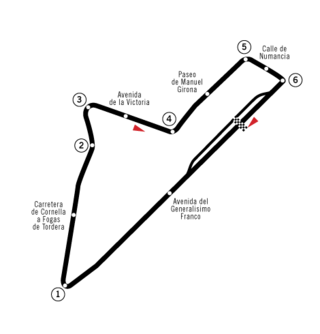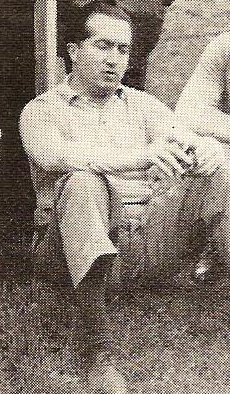
The 1950 Italian Grand Prix was a Formula One motor race held on 3 September 1950 at Autodromo Nazionale di Monza. It was race 7 of 7 in the 1950 World Championship of Drivers. In this race, Nino Farina became the first World Drivers' Champion, and the only driver to win the title in his home country.

The 1951 German Grand Prix was a Formula One motor race held on 29 July 1951 at the Nürburgring Nordschleife. It was race 6 of 8 in the 1951 World Championship of Drivers.

The 1951 Italian Grand Prix was a Formula One motor race held on 16 September 1951 at Monza. It was race 7 of 8 in the 1951 World Championship of Drivers.

The 1952 Swiss Grand Prix was a Formula Two race held on 18 May 1952 at Bremgarten Circuit. It was the first round of the 1952 World Championship of Drivers, in which each Grand Prix was run to Formula Two rules rather than the Formula One regulations normally used.

The 1952 Dutch Grand Prix was a Formula Two race held on 17 August 1952 at the Circuit Zandvoort. It was race 7 of 8 in the 1952 World Championship of Drivers, in which each Grand Prix was run to Formula Two rules rather than the Formula One regulations normally used. The 90-lap race was won by Ferrari driver Alberto Ascari after he started from pole position. His teammates Giuseppe Farina and Luigi Villoresi finished in second and third places. Ascari overtook Fangio's record for the most race wins, scoring his seventh at this race.

The 1953 Argentine Grand Prix was race 1 of 9 in the 1953 World Championship of Drivers, which was run to Formula Two regulations in 1952 and 1953. The race was held in Buenos Aires on 18 January 1953, at the Autódromo Gálvez and was the first World Drivers' Championship race in South America.

The 1953 Dutch Grand Prix was a Formula Two race held on 7 June 1953 at the Circuit Zandvoort. It was race 3 of 9 in the 1953 World Championship of Drivers, which was run to Formula Two rules in 1952 and 1953, rather than the Formula One regulations normally used. The 90-lap race was won by Ferrari driver Alberto Ascari after he started from pole position. His teammate Nino Farina finished second and Maserati drivers José Froilán González and Felice Bonetto came in third

The 1953 Belgian Grand Prix was a Formula Two race held on 21 June 1953 at Circuit de Spa-Francorchamps. It was race 4 of 9 in the 1953 World Championship of Drivers, which was run to Formula Two rules in 1952 and 1953, rather than the Formula One regulations normally used. The 36-lap race was won by Ferrari driver Alberto Ascari after he started from second position. His teammate Luigi Villoresi finished second and Maserati driver Onofre Marimón came in third.

The 1953 French Grand Prix was a Formula Two race held on 5 July 1953 at Reims. It was race 5 of 9 in the 1953 World Championship of Drivers, which was run to Formula Two rules in 1952 and 1953, rather than the Formula One regulations normally used.

The 1953 British Grand Prix was a Formula Two motor race held on 18 July 1953 at Silverstone Circuit. It was race 6 of 9 in the 1953 World Championship of Drivers, which was run to Formula Two rules in 1952 and 1953, rather than the Formula One regulations normally used. The 90-lap race was won by Ferrari driver Alberto Ascari after he started from pole position. Juan Manuel Fangio finished second for the Maserati team and Ascari's teammate Nino Farina came in third.

The 1953 German Grand Prix was a Formula Two motor racing event held on 2 August 1953 at the Nürburgring Nordschleife. It was race 7 of 9 in the 1953 World Championship of Drivers, which was run to Formula Two rules in 1952 and 1953, rather than the Formula One regulations normally used. This race had the highest number of cars on the grid of any World Drivers' Championship race, with 34 starters.

The 1953 Swiss Grand Prix was a Formula Two race held on 23 August 1953 at Bremgarten Circuit. It was race 8 of 9 in the 1953 World Championship of Drivers, which was run to Formula Two rules in 1952 and 1953, rather than the Formula One regulations normally used. World Champion Ferrari driver Alberto Ascari won the race, the last race win and finish of his career.

The 1954 Spanish Grand Prix was a Formula One motor race held on 24 October 1954 at Pedralbes. It was the ninth and final race in the 1954 World Championship of Drivers. The 80-lap race was won by Ferrari driver Mike Hawthorn after he started from third position. Luigi Musso finished second for the Maserati team and Mercedes driver Juan Manuel Fangio came in third.

The 1955 Formula One season was the ninth season of FIA Formula One motor racing. It featured the sixth World Championship of Drivers, which was contested over seven races between 16 January and 11 September 1955. The season also included several non-championship races for Formula One cars.

The 1954 Formula One season was the eighth season of FIA Formula One motor racing. It featured the fifth World Championship of Drivers, which was contested over nine races between 17 January and 24 October 1954. The season also included several non-championship races for Formula One cars.

The 1953 Formula One season was the seventh season of the FIA Formula One motor racing. It featured the 4th World Championship of Drivers, which was contested over nine races between 18 January and 13 September 1953. The season also included several non-championship races and a separate East German Championship.

The 1952 Formula One season was the sixth season of FIA Formula One motor racing. It featured the 3rd World Championship of Drivers, which was contested over eight races between 18 May and 7 September 1952. The season also included several non-championship races and a separate East German Championship.

The 1951 Formula One season was the fifth season of FIA Formula One motor racing. It featured the second World Championship of Drivers, which was contested over eight races between 27 May and 28 October 1951. The season also included several non-championship races for Formula One cars.

The 1950 Formula One season was the fourth season of the FIA Formula One motor racing. It featured the inaugural FIA World Championship of Drivers, which was contested over seven races between 13 May and 3 September 1950. The only one outside of Europe was the Indianapolis 500, which was run to AAA National Championship regulations. No Formula One drivers competed in the Indy 500 or vice versa. Finally, the season also included several non-championship races for Formula One cars.
















